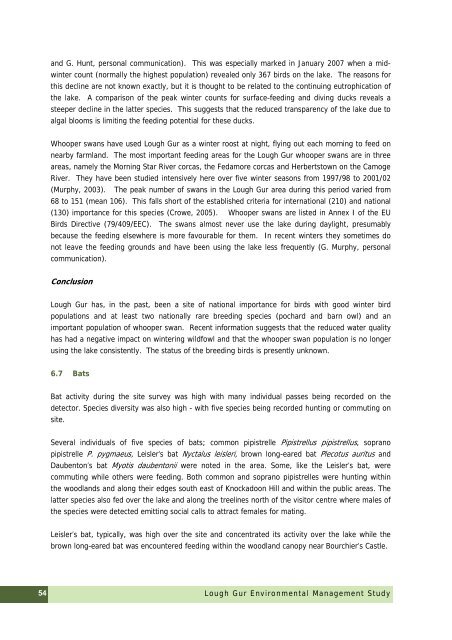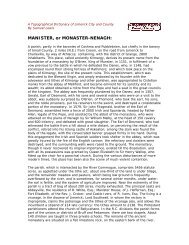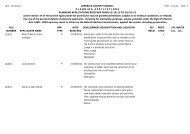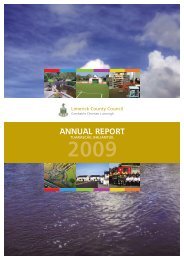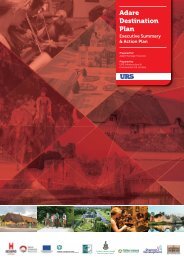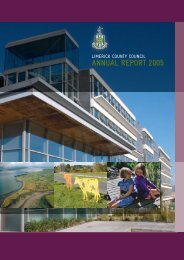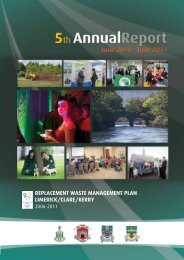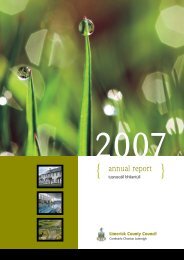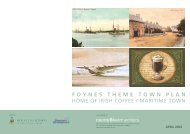Lough Gur Environmental Management Study February 2009
Lough Gur Environmental Management Study February 2009
Lough Gur Environmental Management Study February 2009
Create successful ePaper yourself
Turn your PDF publications into a flip-book with our unique Google optimized e-Paper software.
54<br />
and G. Hunt, personal communication). This was especially marked in January 2007 when a midwinter<br />
count (normally the highest population) revealed only 367 birds on the lake. The reasons for<br />
this decline are not known exactly, but it is thought to be related to the continuing eutrophication of<br />
the lake. A comparison of the peak winter counts for surface-feeding and diving ducks reveals a<br />
steeper decline in the latter species. This suggests that the reduced transparency of the lake due to<br />
algal blooms is limiting the feeding potential for these ducks.<br />
Whooper swans have used <strong>Lough</strong> <strong>Gur</strong> as a winter roost at night, flying out each morning to feed on<br />
nearby farmland. The most important feeding areas for the <strong>Lough</strong> <strong>Gur</strong> whooper swans are in three<br />
areas, namely the Morning Star River corcas, the Fedamore corcas and Herbertstown on the Camoge<br />
River. They have been studied intensively here over five winter seasons from 1997/98 to 2001/02<br />
(Murphy, 2003). The peak number of swans in the <strong>Lough</strong> <strong>Gur</strong> area during this period varied from<br />
68 to 151 (mean 106). This falls short of the established criteria for international (210) and national<br />
(130) importance for this species (Crowe, 2005). Whooper swans are listed in Annex I of the EU<br />
Birds Directive (79/409/EEC). The swans almost never use the lake during daylight, presumably<br />
because the feeding elsewhere is more favourable for them. In recent winters they sometimes do<br />
not leave the feeding grounds and have been using the lake less frequently (G. Murphy, personal<br />
communication).<br />
Conclusion<br />
<strong>Lough</strong> <strong>Gur</strong> has, in the past, been a site of national importance for birds with good winter bird<br />
populations and at least two nationally rare breeding species (pochard and barn owl) and an<br />
important population of whooper swan. Recent information suggests that the reduced water quality<br />
has had a negative impact on wintering wildfowl and that the whooper swan population is no longer<br />
using the lake consistently. The status of the breeding birds is presently unknown.<br />
6.7 Bats<br />
Bat activity during the site survey was high with many individual passes being recorded on the<br />
detector. Species diversity was also high - with five species being recorded hunting or commuting on<br />
site.<br />
Several individuals of five species of bats; common pipistrelle Pipistrellus pipistrellus, soprano<br />
pipistrelle P. pygmaeus, Leisler’s bat Nyctalus leisleri, brown long-eared bat Plecotus auritus and<br />
Daubenton’s bat Myotis daubentonii were noted in the area. Some, like the Leisler’s bat, were<br />
commuting while others were feeding. Both common and soprano pipistrelles were hunting within<br />
the woodlands and along their edges south east of Knockadoon Hill and within the public areas. The<br />
latter species also fed over the lake and along the treelines north of the visitor centre where males of<br />
the species were detected emitting social calls to attract females for mating.<br />
Leisler’s bat, typically, was high over the site and concentrated its activity over the lake while the<br />
brown long-eared bat was encountered feeding within the woodland canopy near Bourchier’s Castle.<br />
<strong>Lough</strong> <strong>Gur</strong> <strong>Environmental</strong> <strong>Management</strong> <strong>Study</strong>


